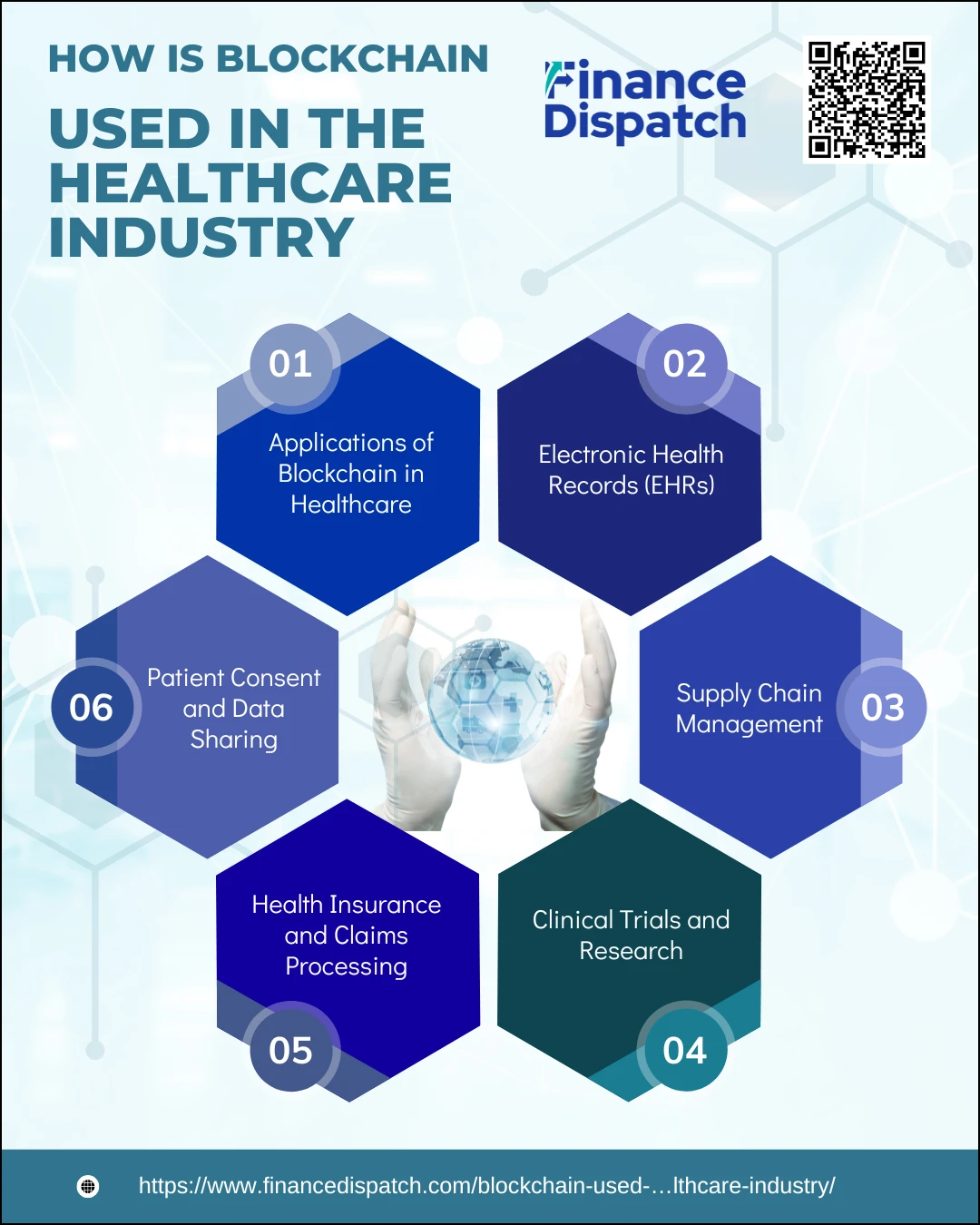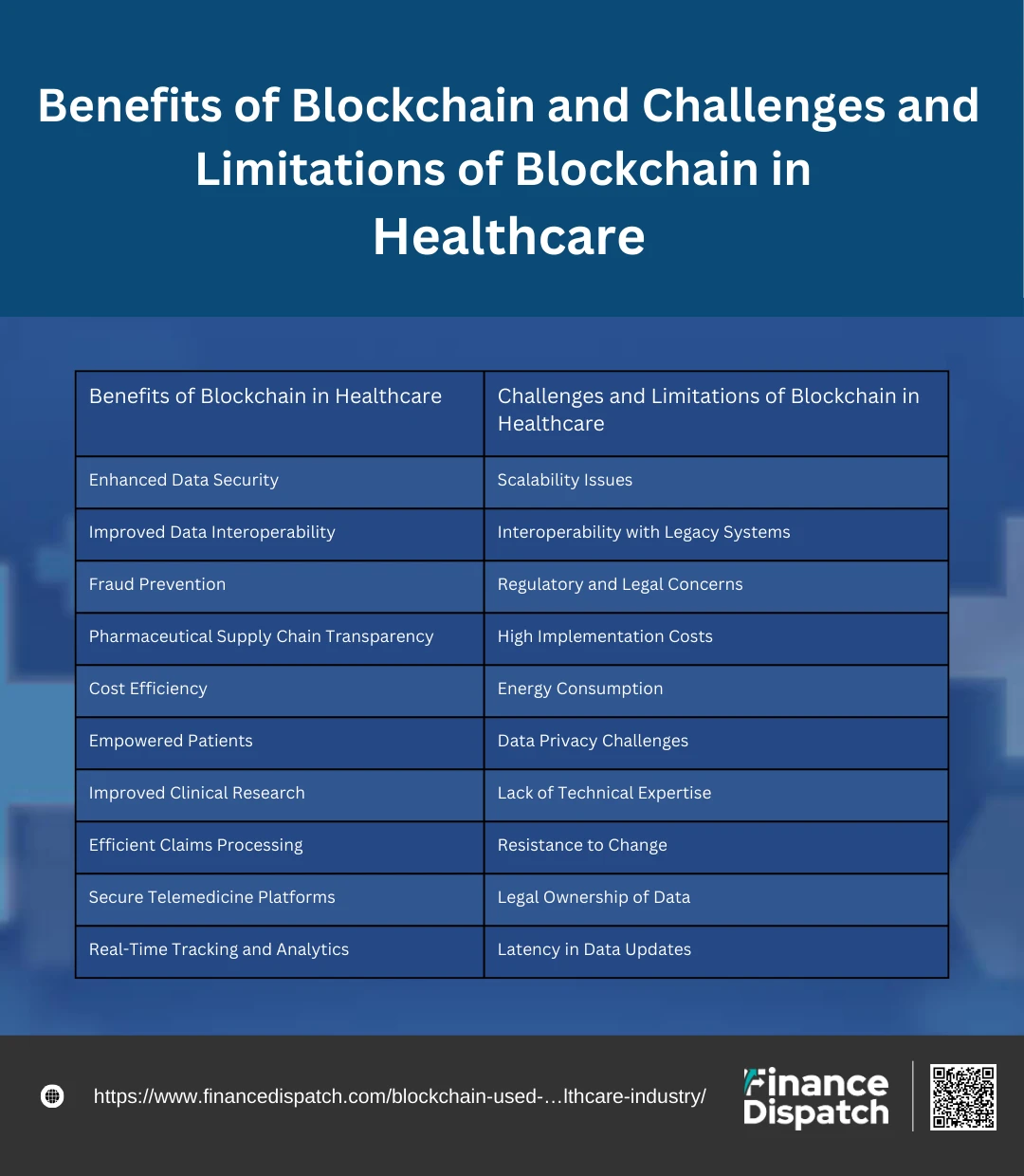Blockchain technology, originally developed to underpin cryptocurrencies, is now revolutionizing the healthcare industry. With its decentralized, secure, and immutable nature, blockchain offers innovative solutions to some of the most pressing challenges in healthcare, including data security, patient privacy, and supply chain management. By enabling the safe transfer of medical records, streamlining pharmaceutical logistics, and fostering interoperability between healthcare providers, blockchain is paving the way for a more transparent and efficient system. This article explores the diverse applications of blockchain in healthcare, highlighting its transformative potential and the practical ways it is being implemented across the industry.

1. Applications of Blockchain in Healthcare
Blockchain technology is revolutionizing the healthcare industry by enhancing transparency, security, and efficiency in managing sensitive health-related data and processes. Its decentralized and immutable nature offers robust solutions to some of the most pressing challenges in healthcare, from data security to operational inefficiencies. Below are some key applications of blockchain in healthcare:
2. Electronic Health Records (EHRs)
Blockchain enhances the management of electronic health records by improving interoperability and ensuring patient-centric data control. Traditional EHR systems often struggle with fragmented data, limiting the seamless sharing of information between providers. Blockchain enables a unified, interoperable system where patients can control access to their records, ensuring they remain at the center of healthcare decisions. Furthermore, blockchain’s cryptographic features provide robust data integrity and security, protecting patient records from breaches and unauthorized modifications.
3. Supply Chain Management
In the pharmaceutical supply chain, blockchain helps combat counterfeit drugs by providing end-to-end tracking and verification. Each step of the manufacturing and distribution process is recorded on the blockchain, ensuring the authenticity and provenance of pharmaceuticals. Additionally, blockchain fosters transparency and traceability in medical supplies, ensuring that critical equipment and medications reach their intended destinations without delays or discrepancies.
4. Clinical Trials and Research
Blockchain ensures the integrity and transparency of data in clinical trials and research. By timestamping and securing records, researchers can maintain a trustworthy and tamper-proof audit trail for all trial data. Moreover, blockchain facilitates secure and efficient data sharing among research teams and institutions, accelerating innovation while safeguarding intellectual property and sensitive participant information.
5. Health Insurance and Claims Processing
The inefficiencies and fraud prevalent in traditional health insurance processes can be mitigated with blockchain. Smart contracts enable automated claims adjudication, reducing delays and disputes. This automation streamlines workflows and significantly lowers administrative costs. By creating a transparent and secure ledger of transactions, blockchain also minimizes the risk of fraudulent claims, fostering trust between insurers and policyholders.
6. Patient Consent and Data Sharing
Blockchain empowers patients by giving them control over their health data. Through secure, decentralized platforms, patients can manage who has access to their information and revoke it when necessary. Consent management becomes simpler and more transparent, enabling faster data sharing without compromising privacy. This ensures compliance with data protection regulations while improving patient confidence in the healthcare system.

Benefits of Blockchain in Healthcare
Blockchain technology is reshaping healthcare with its potential to address critical inefficiencies and risks in data management, security, and operations. Its unique features—decentralization, immutability, transparency, and automation—are enabling breakthroughs in patient care, operational efficiency, and regulatory compliance. Below is a deeper dive into each benefit of blockchain in healthcare:
1. Enhanced Data Security
Data breaches in healthcare are not only financially damaging but also undermine patient trust. Blockchain secures data using cryptographic algorithms and stores it across a decentralized network, making it nearly impossible for hackers to compromise or alter records. Each access or modification request is logged immutably, creating a comprehensive audit trail. This enhanced security is particularly critical for patient health records, insurance details, and genetic data, which are highly sensitive and valuable targets for cybercriminals.
2. Improved Data Interoperability
The healthcare industry suffers from fragmented systems that hinder seamless communication and data sharing among providers, insurers, and researchers. Blockchain creates a shared, standardized, and decentralized framework that bridges these silos. It enables authorized participants to access real-time, accurate patient information, reducing duplication of tests, enhancing care coordination, and enabling faster decision-making. For example, during emergencies, blockchain ensures physicians can quickly retrieve a patient’s comprehensive medical history without delays caused by disparate systems.
3. Fraud Prevention
Fraudulent activities, such as falsified insurance claims, manipulation of trial results, or counterfeit billing, are common in healthcare. Blockchain’s immutable ledger ensures that every transaction or data exchange is traceable and verifiable. For example, insurers can use blockchain to verify claims against actual patient data recorded on the blockchain, eliminating discrepancies and false claims. Similarly, research institutions can ensure clinical trial data remains transparent and unaltered, preserving the credibility of their findings.
4. Pharmaceutical Supply Chain Transparency
The global circulation of counterfeit drugs is a pressing challenge, with harmful consequences for patient safety and public trust. Blockchain provides an unbroken, end-to-end record of the pharmaceutical supply chain, documenting every stage, from manufacturing to distribution and sale. Stakeholders can verify the authenticity and source of medications through blockchain records. Patients can also scan QR codes on medications to trace their origin, ensuring they receive genuine products.
5. Cost Efficiency
Administrative inefficiencies, manual processes, and redundant systems contribute significantly to rising healthcare costs. Blockchain automates various workflows using smart contracts, which execute predefined actions without the need for intermediaries. For example, claims processing becomes faster and error-free as smart contracts automatically validate patient data and insurer terms, triggering payments once conditions are met. This reduces paperwork, operational bottlenecks, and associated costs.
6. Empowered Patients
Blockchain shifts the control of medical data from providers to patients. Through cryptographic keys, patients can decide who has access to their records and what level of access is granted. For instance, a patient can share specific data with a specialist while keeping other details private. This control fosters trust and transparency, empowering patients to play an active role in managing their healthcare journey.
7. Improved Clinical Research
Clinical trials often face challenges related to data integrity, transparency, and participant recruitment. Blockchain provides a tamper-proof platform for recording trial data, ensuring that every data point is accurate and verifiable. Researchers can track changes, monitor data usage, and ensure compliance with ethical standards. Blockchain also facilitates secure sharing of anonymized patient data, encouraging participation in trials while protecting privacy.
8. Efficient Claims Processing
The insurance claims process is prone to delays, disputes, and inefficiencies due to manual verification and lack of transparency. Blockchain simplifies this by providing a shared, immutable record of patient treatments and payments. Smart contracts automatically verify claims against recorded data, approve valid claims, and trigger payments without requiring manual intervention. This reduces errors, shortens processing times, and improves trust between patients, providers, and insurers.
9. Secure Telemedicine Platforms
Telemedicine is revolutionizing healthcare access, especially in remote and underserved areas. However, it involves the exchange of highly sensitive patient information over digital platforms. Blockchain secures this data exchange with its decentralized and encrypted framework, ensuring that patient-provider interactions remain confidential and tamper-proof. This builds trust in telehealth services and facilitates broader adoption.
10. Real-Time Tracking and Analytics
Blockchain supports real-time tracking and analysis of health data, enabling better decision-making and resource allocation. For example, wearable devices connected to blockchain can continuously update patient health metrics, such as heart rate or glucose levels, in real-time. Providers can monitor this data securely and intervene promptly if any anomalies are detected. Blockchain also helps track the usage and distribution of medical supplies, ensuring resources are available where they’re needed most.
Challenges and Limitations of Blockchain in Healthcare
While blockchain offers transformative potential for healthcare, several challenges and limitations hinder its widespread adoption. These issues range from technical constraints to regulatory and operational barriers. Below is a detailed breakdown of these challenges:
1. Scalability Issues
Blockchain systems can struggle to handle the sheer volume of data generated by healthcare systems, such as electronic health records (EHRs), imaging files, and real-time monitoring data. As the number of transactions increases, the network may experience slower performance, delays, or higher costs. This scalability problem is particularly acute in public blockchains, which rely on consensus mechanisms that require significant computational resources.
2. Interoperability with Legacy Systems
Many healthcare organizations rely on outdated or siloed systems that are not designed to integrate with blockchain technology. These legacy systems often use inconsistent data formats and lack standardization, making it challenging to achieve seamless interoperability. Transitioning to blockchain requires significant effort to bridge these gaps, which can slow down adoption.
3. Regulatory and Legal Concerns
The healthcare industry is governed by stringent data privacy and security regulations, such as the Health Insurance Portability and Accountability Act (HIPAA) in the U.S. and the General Data Protection Regulation (GDPR) in the EU. Blockchain’s immutability, while a strength, can conflict with laws requiring data modification or deletion (e.g., the “right to be forgotten”). Ensuring blockchain solutions comply with these regulations without compromising their core functionalities is a complex challenge.
4. High Implementation Costs
Deploying blockchain systems requires significant upfront investment in hardware, software, and personnel training. For smaller healthcare organizations, these costs may be prohibitive. Additionally, ongoing expenses for maintaining and updating the system add to the financial burden, making blockchain adoption less feasible for resource-constrained providers.
5. Energy Consumption
Public blockchains, especially those using proof-of-work consensus mechanisms, consume large amounts of energy. This high energy demand raises concerns about environmental sustainability, particularly in industries like healthcare, where ethical considerations are paramount. Transitioning to less energy-intensive models, such as proof-of-stake or private blockchains, may alleviate this issue but introduces other trade-offs.
6. Data Privacy Challenges
While blockchain enhances data security through encryption and decentralization, its transparency can pose privacy risks. For example, if patient data is stored on a public blockchain, even encrypted, there is a potential risk of re-identification through advanced analytics. Careful design, such as using off-chain data storage with on-chain pointers, is needed to mitigate this concern.
7. Lack of Technical Expertise
Implementing and managing blockchain systems require specialized skills in blockchain development, cybersecurity, and data management. Many healthcare organizations lack in-house expertise, making them dependent on third-party vendors. This reliance can increase costs and limit the organization’s ability to customize or troubleshoot the system.
8. Resistance to Change
Healthcare organizations often resist adopting new technologies due to the disruption they bring to established workflows. Blockchain implementation may require significant retraining, changes to operational processes, and cultural shifts within organizations. Resistance from stakeholders such as staff, patients, or insurers can hinder adoption.
9. Legal Ownership of Data
Blockchain’s decentralized architecture raises questions about data ownership and accountability. For example, who owns and controls the data when it is stored on a blockchain shared among multiple entities? This ambiguity can lead to disputes over data access, governance, and responsibility, especially in scenarios involving sensitive patient information.
10. Latency in Data Updates
Blockchain’s design can introduce delays in data synchronization and processing, particularly in large networks or those relying on public blockchains. For healthcare applications requiring real-time updates, such as remote monitoring or emergency care, even small delays can have significant consequences. Addressing this latency requires the adoption of optimized consensus algorithms or hybrid systems.
Real-World Examples of Blockchain in Healthcare
Blockchain technology is already making a tangible impact in the healthcare industry, with several organizations and projects demonstrating its transformative potential. From securing patient data to streamlining pharmaceutical supply chains and enhancing clinical trials, blockchain is addressing critical challenges and creating more efficient and transparent healthcare systems.
Real-World Examples of Blockchain in Healthcare
1. BurstIQ: Secure Patient Data Management
BurstIQ, based in Denver, Colorado, provides a blockchain platform for securely managing and sharing patient data. The platform allows healthcare organizations to store sensitive health information in a decentralized and tamper-proof system. Patients retain control over their data and can share it with authorized providers, enhancing privacy and trust.
2. Guardtime: Clinical Trial Data Integrity
Guardtime, headquartered in Estonia, specializes in using blockchain to ensure the integrity of clinical trial data. By creating a transparent and immutable record of trial transactions, Guardtime helps researchers maintain data accuracy and prevent tampering, fostering trust in research outcomes. It has been implemented in collaborations with governments and healthcare organizations.
3. Chronicled: Pharmaceutical Supply Chain Transparency
Chronicled, a San Francisco-based company, uses blockchain to address counterfeit drugs in the pharmaceutical supply chain. Their MediLedger project enables end-to-end traceability of drugs, ensuring that only authentic medications reach patients. This initiative builds trust and compliance in the industry while improving safety.
4. Medicalchain: Decentralized Health Records
Medicalchain, headquartered in London, leverages blockchain to create a secure system for managing electronic health records (EHRs). Patients can access and control their health data, sharing it with healthcare providers as needed. Medicalchain also integrates blockchain-based tokens for telemedicine services, enabling seamless payment and data exchange.
5. Patientory: Patient Data Storage and Sharing
Patientory, based in Atlanta, Georgia, uses blockchain to provide an end-to-end encrypted platform for patient data management. The platform allows healthcare providers to securely share data, improving care coordination and operational efficiency. Patients can monitor their medical history and gain better control over their healthcare journey.
6. Robomed Network: Telemedicine and IoT Integration
Robomed, a New York-based platform, integrates blockchain with IoT and AI technologies to revolutionize telemedicine. It enables secure remote patient monitoring through wearable devices, transmitting real-time health data to providers. Blockchain ensures that this data remains private and unaltered, improving patient outcomes.
7. Blockpharma: Counterfeit Drug Prevention
Blockpharma, based in Paris, uses blockchain to combat counterfeit drugs. The platform tracks the journey of medications through the supply chain, allowing stakeholders to verify their authenticity. Patients can scan QR codes on packaging to confirm that the medication is genuine and safe.
8. EncrypGen: Genomic Data Sharing
EncrypGen, headquartered in New York, developed Gene-Chain, a blockchain-based platform for securely sharing genomic data. Researchers and healthcare providers can access anonymized genetic information for studies, while patients retain control over who can view their data. This fosters advancements in personalized medicine while protecting privacy.
9. Avaneer Health: Healthcare Data Exchange
Avaneer Health, based in Illinois, utilizes blockchain to enable seamless data exchange among healthcare organizations. Backed by leading healthcare providers, the platform facilitates efficient claims processing, patient data sharing, and provider directory management, improving overall healthcare operations.
10. IBM Blockchain: Vaccine Distribution Tracking
IBM Blockchain has been deployed to improve vaccine distribution logistics. By providing end-to-end visibility into vaccine storage and transportation, the platform ensures that vaccines are delivered safely and efficiently. Blockchain’s transparency helps maintain trust and compliance in global vaccination efforts.
Future of Blockchain in Healthcare
The future of blockchain in healthcare holds immense potential to revolutionize the industry, making it more secure, efficient, and patient-centric. As the technology evolves, it is likely to address critical challenges such as data interoperability, patient privacy, and fraud prevention on a larger scale. Innovations like blockchain-based health record systems could give patients full control over their medical data, while smart contracts may automate complex processes such as insurance claims and payment settlements. Additionally, blockchain’s ability to enhance supply chain transparency will play a pivotal role in combating counterfeit drugs and ensuring the integrity of medical supplies. As more stakeholders, including healthcare providers, insurers, and pharmaceutical companies, adopt blockchain, its integration with emerging technologies like artificial intelligence (AI) and the Internet of Things (IoT) is expected to unlock unprecedented advancements in personalized medicine, real-time patient monitoring, and public health management. However, addressing current challenges, including scalability, regulatory compliance, and high implementation costs, will be crucial to realizing blockchain’s full potential in healthcare. With continued research, collaboration, and investment, blockchain is poised to become a cornerstone of a more efficient and trustworthy global healthcare ecosystem.
Conclusion
Blockchain technology is transforming healthcare by addressing some of its most persistent challenges, including data security, interoperability, and inefficiencies in operations. Its decentralized and transparent framework offers a robust solution for managing sensitive medical data, streamlining supply chains, and empowering patients with control over their health information. While challenges such as scalability, regulatory compliance, and high implementation costs remain, ongoing advancements and collaborations among industry stakeholders are paving the way for broader adoption. As blockchain continues to integrate with emerging technologies like AI and IoT, its potential to revolutionize healthcare systems globally becomes increasingly evident. By fostering trust, enhancing efficiency, and prioritizing patient-centric care, blockchain is poised to be a cornerstone of a more secure, innovative, and inclusive healthcare future.
FAQs
1. How can blockchain improve patient consent management?
Blockchain can enhance patient consent management by storing consent records on an immutable ledger. Patients can use blockchain to provide or revoke access to their medical data in real time, ensuring that healthcare providers and researchers only access information with explicit permission. This improves transparency and builds trust between patients and stakeholders.
2. Can blockchain support global health initiatives and data sharing?
Yes, blockchain can facilitate secure and standardized data sharing across international borders. It enables global health organizations to collaborate effectively by providing access to real-time, verified data on disease outbreaks, vaccination rates, and medical supplies while ensuring compliance with local privacy regulations.
3. What role does blockchain play in medical device tracking?
Blockchain can track the lifecycle of medical devices, from manufacturing to deployment and maintenance. It creates an immutable record of the device’s history, including calibration, repair, and updates, ensuring safety, regulatory compliance, and accountability in healthcare systems.
4. How does blockchain handle large datasets like medical imaging?
Blockchain is not designed to store large files directly, but it can store metadata and hashes that reference off-chain data stored securely in external systems. This hybrid approach ensures that large datasets like MRIs or CT scans remain tamper-proof and accessible only to authorized parties.
5. What are the potential ethical concerns with blockchain in healthcare?
While blockchain enhances data security and transparency, it may raise ethical concerns such as how data ownership is defined, how anonymized data might be used for profit, and the environmental impact of energy-intensive blockchain networks. Addressing these concerns will require clear policies and regulations that balance innovation with ethical considerations.



